Native Mental Health Providers Seek to Heal Boarding School Scars
Therapists and social workers are part of a holistic, community-centered response to honor and uplift survivors.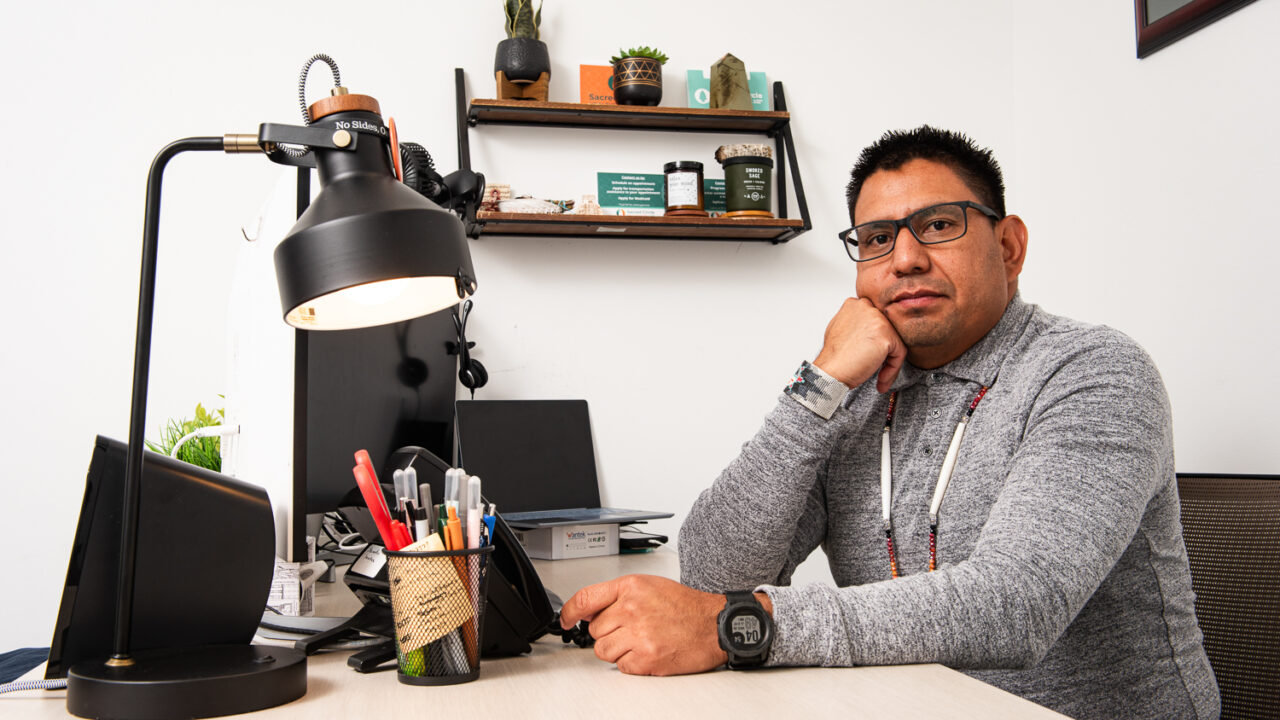 Secadio Sanchez (Diné) is a behavioral health therapist at Sacred Circle Healthcare in Salt Lake City. Photo: Russel Albert Daniels/High Country News.
Secadio Sanchez (Diné) is a behavioral health therapist at Sacred Circle Healthcare in Salt Lake City. Photo: Russel Albert Daniels/High Country News.
Blood memory need not be rooted in violence. In the 2021 anthology, New World Coming: Frontline Voices on Pandemics, Uprisings and Climate Crisis, filmmaker and Indigenous rights and climate activist Jade Begay (Diné and Tesuque Pueblo) described blood memory as “an embodied remembrance passed down from generation to generation. … Sometimes they are good and joyful, and sometimes they are traumatic and rooted in grief.”
For Native children growing up in the Intermountain West in the wake of World War II, the link between trauma and blood memory is often tied to their experience in federally funded boarding schools. Children were rounded up, sometimes at gunpoint, and forced from their homelands to attend these schools, according to members of the Greyhound Generation, the Native elderly who can trace their ancestral blood memory of stories from the late 1800s to the present. The boarding school era, between 1819 and 1969, fractured families and communities. Unknown numbers of children went missing, either dying on the school grounds or running off and never being found. Throughout this tragic period of assimilation, children experienced physical, emotional and sexual abuse at the hands of school staff.
Blood memory for many of the boarding school survivors known as the Greyhound Generation takes the form of being shuttled around on flatbed trailers and Greyhound buses from a boarding school in northern Arizona to one hundreds of miles away in southern Utah, or riding in the back of a truck past the Hopi mesas to attend a Presbyterian school. It’s holding the stories passed on by elders from the early 1900s, who had their heads shaved bald at school. Children who were disciplined by non-Native school staff with a paddle later ended up using those same abusive methods on their own children, the Baby Boomers, who then passed it onto their Gen X and Millennial grandchildren of today.
For Indigenous communities, much of this past trauma is tied at some level to the forces of colonization and the attempted genocide by the United States and European governments.
These conditions — a byproduct of U.S. militarism, as America fought to expand its land holdings in the 19th and 20th centuries — left survivors with what is now known as complex post-traumatic stress disorder or PTSD. This complex PTSD, a violent version of blood memory, is rarely treated or even diagnosed, and so it is generally seen as the norm.
But it doesn’t have to be that way.
Secadio Sanchez (Diné) is a behavioral health therapist in Salt Lake City. Both through blood memory and his own lived experience, he has seen the dual benefits of traditional healing and behavioral health therapy. Members of his Diné clan, Tó’áhani (Near The Water People), are commonly known as healers across the Navajo Nation. Sanchez works at Sacred Circle Healthcare, which is owned and operated by the Confederated Tribes of the Goshute Reservation. Along with cultural support through various Indigenous healing methods, Sacred Circle Healthcare offers trauma-informed care for Salt Lake City’s urban Indigenous population.
He envisions more Native American and Alaska Native community members healing themselves from their traumatic experiences, including the intergenerational trauma of boarding school survivors, by blending traditional healing with behavioral health therapy.
“Trauma — we know that it lives and exists in the body,” Sanchez said, explaining that it can be passed from one generation to another through blood memory. “Trauma is something that occurred; whether it happened in your generation or your parents’ generation or not, it is still there.”
His clients, who range in cultural identity from Diné (Navajo), Goshute and Paiute to Shoshone, Ute and many other tribes, often present symptoms of anxiety and depression. But few of them enter his office with a full understanding of how their past trauma affects their health and mental well-being, Sanchez said, and they lack the tools to process their own experiences. As a mental health provider, Sanchez has been able to trace some of the risk factors for PTSD-associated anxiety.
Blood memory and lingering trauma are widespread issues that have begun to receive more acknowledgment in recent years. In his 2014 book, The Body Keeps the Score: Brain, Mind and Body in the Healing of Trauma, Dr. Bessel van der Kolk wrote that unresolved trauma prevents people from living a full life, owing to the ways that fear and insecurity stemming from past events can impact a person’s present existence.
“Traumatized people chronically feel unsafe inside their bodies: The past is alive in the form of gnawing interior discomfort,” van der Kolk wrote. “Their bodies are constantly bombarded by visceral warning signs, and, in an attempt to control these processes, they often become expert at ignoring their gut feelings and in numbing awareness of what is played out inside. They learn to hide from their selves.”
According to the Substance Abuse and Mental Health Services Administration, anxiety and depression are the leading causes of mental health issues in Native communities.
For Indigenous communities, much of this past trauma is tied at some level to the forces of colonization and the attempted genocide by the United States and European governments. The forced removal of tribes and pueblos from their homelands, accompanied by physical, sexual and domestic violence; assimilative adoption practices and the boarding school system — these all contribute to the ongoing emotional repression that van der Kolk outlined.
Anxiety, Sanchez said, is a common symptom among the Indigenous people he treats. According to the Substance Abuse and Mental Health Services Administration, anxiety and depression are the leading causes of mental health issues in Native communities. The Indian Health Service reports that American Indians and Alaska Natives are 2.5 times more than the general population to experience psychological distress. Once his clients receive proper treatment and become able to understand and process their personal trauma, they can begin to do the heavy work of reprocessing their behavioral patterns and distinguishing between their past, present and future. This allows them to become more aware of how past trauma can impact daily living.
“We can provide interventions that are focused for Natives, that’s going to work for Natives, that bring familiarity to those who have experienced trauma,” Sanchez said. He added that most of the anxiety seen in clients stems from identity confusion, which comes with feelings of guilt, shame and betrayal — all rooted in the colonial structures that challenge Indigenous identities.
Some tribal leaders in the Intermountain West have called for an increase in mental health services. In 2022, Navajo Nation Council Delegate Carl Slater told High Country News that the federal government needs to go beyond its Interior Department-led boarding-school review and start providing health resources for survivors. “You just can’t remove the bandage when you have not done enough to actually help heal the person and the people,” Slater said. “The (federal) report is just a report without action.”
The National Native American Boarding School Healing Coalition, which is providing technical assistance to the Department of the Interior in its ongoing Federal Indian Boarding School Initiative investigation, has a program dedicated to healing. Led by Sandy White Hawk (Sicangu Lakota), the program seeks to address the historical legacies of the federal boarding school era by offering workshops on coping with trauma, anxiety and depression. In 2022, the healing coalition held four in-person healing events in Oklahoma, Minnesota and Alaska, as well as seven virtual workshops. A total of 450 people attended the in-person workshops. This year, the healing coalition sponsored virtual workshops — two focused on traditional plant medicines and one on how trauma affects the brain.
The effectiveness of these workshops, White Hawk said, depends on the individual, so at this time the healing coalition cannot measure its impact. Most attendees enjoyed learning about traditional plant medicines, she said, adding that it is critical for mental health providers like Sanchez — as well as the federal government — to remember that their work is vital to achieving healthier outcomes in Indigenous communities. But they need to take a slow and gentle approach, remembering that the Indigenous elders of today endured years and years of bullying and trauma at boarding schools during their critical developmental years.
“I would like them to know and understand that what happened to them is not their fault,” White Hawk said, and that any contemporary struggle they may experience “is an outcome of that trauma in their behaviors that was not healthy.”
Honoring the legacy of the boarding school era survivors also requires the heavy process of understanding the historical context of colonization and its many facets.
White Hawk emphasized the need for strong and gentle support for boarding school survivors as they consider what steps they want or need to take to address their trauma. She also wants the coalition to be thinking about how it can help those already on their healing journeys to continue their progress.
Honoring the legacy of the boarding school era survivors also requires the heavy process of understanding the historical context of colonization and its many facets, says Dena Ned, a citizen of the Chickasaw Nation. In her role as a professor and social worker at the University of Utah, she examines how the U.S. government and society removed Indigenous peoples from their homes and landscapes, employing various assimilation tactics in cruel and annihilating ways. Ned pointed out that health-care providers often approach Indigenous patients with a view shaped by settler-colonialism, establishing harmful stereotypes about Native communities and leaving the true causes and impacts of trauma unknown — and untreated.
Beyond the Interior Department’s investigation and any mental health treatment options, Ned said that Native families need to engage in more open and transparent dialogue. This can help them process the ways that colonization might have shaped their family and community histories. The American health-care system currently focuses on immediate symptom relief and treatment through pharmaceuticals, disregarding the social determinants of health, a public health theory that looks at how non-medical factors influence a person’s overall health.
“You gotta go to a deeper level,” Ned says. “We need more support for our community members to become experts in these areas or trained as community practitioners.”
It’s part of the work that mental health providers like Sanchez, advocates like White Hawk and social workers like Ned all see as part of a holistic, community-centered response, one that can honor and uplift the relatives and ancestors who bore the brunt of federal termination and assimilation policies — one that can relieve the pain of the past in the name of building a healthier future.
“They survived and are here,” White Hawk said, “and for that we want to honor them.”
Your support matters…Independent journalism is under threat and overshadowed by heavily funded mainstream media.
You can help level the playing field. Become a member.
Your tax-deductible contribution keeps us digging beneath the headlines to give you thought-provoking, investigative reporting and analysis that unearths what's really happening- without compromise.
Give today to support our courageous, independent journalists.
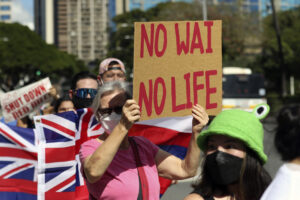
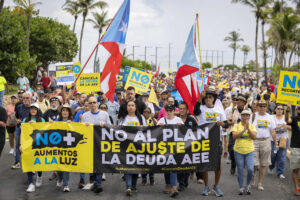


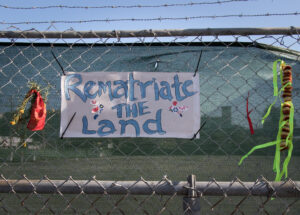
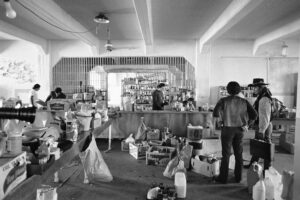
You need to be a supporter to comment.
There are currently no responses to this article.
Be the first to respond.